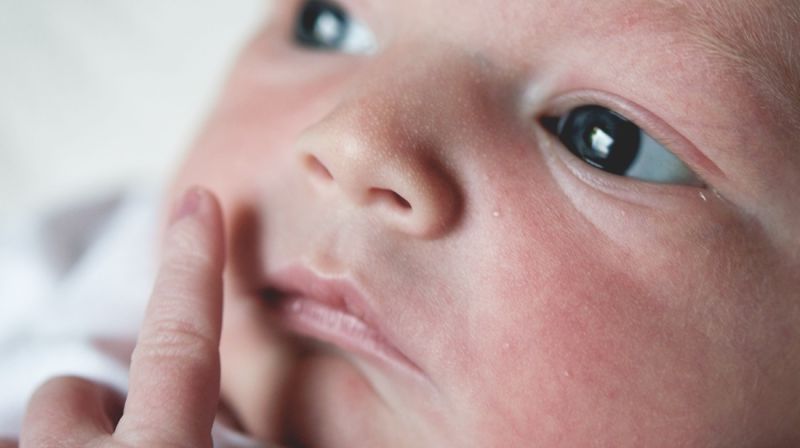Winkelwagen
U heeft geen artikelen in uw winkelwagen
Het lijkt wel alsof elke uitslag met rode pukkeltjes in de volksmond baby acne wordt genoemd. Toch komt echte, officiële Acne neonatorum – oftewel baby acne – bij ‘slechts’ ongeveer twintig procent van de baby’s voor. Het kenmerkt zich voornamelijk door de aanwezigheid van mee-eters, puistjes en rode pukkeltjes, meestal alleen op het gezichtje van je baby.
Naast Acne neonatorum, zijn er nog twee andere vormen van acne, die ik hieronder beschrijf. Door sommige dermatologen worden deze vormen als een heel andere huidaandoening beschouwd, weer anderen vinden het gewoon een variant van de ‘echte’ baby acne. Hoe dan ook, naar mijn mening horen ze zeker op deze adviespagina thuis.
Neonatale cephale pustulose – ook bekend als Neonatale acne of gistpuistjes – is een huidaandoening waarbij er puistjes en pukkeltjes ontstaan in het gezicht en op de hoofdhuid, één tot drie weken na de geboorte. De oorzaak van deze huidaandoening ligt waarschijnlijk bij een gist, genaamd Malassezia furfur. Deze gist heeft iedereen op de huid, maar geeft niet altijd problemen.
Neonatale cephale pustulose is een onschuldige huiduitslag die ontzettend vaak voorkomt en vanzelf overgaat, maar dit kan wel een aantal weken of maanden duren.
Erythema toxicum neonatorum is een huidaandoening die echt heel vaak voorkomt (bij ongeveer de helft van alle pasgeborenen). Enkele dagen na de geboorte ontstaan er rode vlekjes waar een wit-geel puistje op komt. Het lijken wel vlooienbeetjes. Ze kunnen voorkomen in het gezicht, op de romp, armen en benen, maar zitten nooit op de voetzolen of handpalmen.
De oorzaak van deze huidaandoening is nog niet duidelijk. De rode vlekjes en wit-gele puistjes verdwijnen doorgaans vanzelf na enkele dagen en veroorzaken geen andere klachten. Het verschil met ‘echte’ baby acne is dat deze uitslag heel snel weer weggaat en er ook nooit mee-eters zijn te zien.
Alles wat op een pukkeltje of puistje lijkt, wordt al snel als baby acne gezien echter zijn er wel wat verschillen en niet iedere pukkel of puist is baby acne:
Acne neonatorum is een vorm van baby acne die lijkt op de acne die pubers krijgen. Vertaal je deze naam, dan krijg je letterlijk de term ‘acne bij pasgeborenen’. Deze huiduitslag begint in de eerste twee, drie weken na de geboorte, en zie je vooral terug op de hoofdhuid, in het gezicht, hals borst en nek. Meestal verdwijnt de acne binnen een paar weken vanzelf. Een behandeling is daarom ook niet nodig. Het is ook eigenlijk geen baby acne omdat er geen sprake is van mee-eters. Bij echte baby acne zie je deze wel maar dat kom eigenlijk pas voor bij een baby van 6 maanden en ouder.
Deze huiduitslag noemt men ook wel Borelingboutons en komt bij ongeveer 50% van alle pageboren baby’s voor. Het zijn kleine 1 tot 3 mm puistjes met rode vlekjes. Soms wordt het geen puistje maar blijft het alleen een rood vlekje. Deze vlekjes zie je vooral op de romp van de baby, maar komen ook voor in het gezicht en op de armen en benen. Op de palmen van de voeten en handen zitten ze niet. Deze vorm geeft weinig klachten en binnen een dag of 14 verdwijnt het weer. Er is dan ook geen behandeling nodig.
Deze puistjes barsten open en laten een bruinvlekje met schilvering na. Deze puistjes zijn al bij de geboorte aanwezig of verschijnen in de eerste twee dagen na de geboorte. Deze huidaandoening komt vooral voor bij kinderen met een donker huid (ongeveer 5%), bij blanke kinderen komt het een stuk minder vaak voor. Deze puistjes komen vooral voor in het gezicht, de hals, de liezen, de billen en hand- en voet palmen. De puistjes verdwijnen vanzelf, echter kan het maanden duren voordat de vlekjes verdwijnen.

Al die pukkeltjes op de wangen of het lijfje van je baby, dat vinden veel ouders geen leuk gezicht. Gelukkig zijn de hierboven beschreven huidaandoeningen onschuldig en heb je iets aan de baby acne tips. Het is dan ook lang niet altijd nodig om de acne te behandelen. Over het algemeen gaat het na enkele (een tot drie) maanden vanzelf over, en laat het ook meestal geen littekens achter.
Wanneer de acne toch niet vanzelf overgaat, wanneer je het wel heel lang vindt duren of wanneer je kindje erg veel pukkeltjes heeft en je je zorgen maakt, kan je naar de huisarts gaan of dit bespreken op het consultatiebureau. Een arts kan lokale middelen (crèmes) voorschrijven die je plaatselijk op de huid smeert.
Ook bij ernstige vormen is het raadzaam de huisarts of een dermatoloog te bezoeken, want dan kan een medicijnbehandeling wél nodig zijn om littekens te voorkomen.
En wanneer je baby naast de huiduitslag ook ziek is, of wanneer de huiduitslag abnormaal lijkt, is het verstandig naar de huisarts te gaan. Gele korsten om de neus en mond kunnen wijzen op op krentenbaard. Heeft je kindje met vocht gevulde blaasjes van verschillende grootte, dan kan het gaan om een klassieke kinderziekte, zoals de zesde ziekte of waterpokken.

De bultjes die je kindje krijgt als hij of zij te maken krijgt met ENT, zijn erg herkenbaar. Deze zitten voornamelijk in het gezicht van je kindje, maar kunnen ook in de hals, op de schouders of elders op de huid zitten. De bultjes zijn lichtgeel en wit. Ze voelen vast aan en zijn ongeveer één tot drie millimeter groot. Sommige bultjes ontwikkelen zich tot blaasjes of puistjes, andere bultjes niet.
Heeft je kindje acne neonatorum? Dan zien de puistjes er iets anders uit. De puistjes die je kindje bij deze vorm van baby acne krijgt, zitten voornamelijk op de wangen. Ze zien er echt uit als puistjes, zoals je die misschien zelf vroeger ook hebt gehad. Je kindje kan rode bultjes krijgen, maar ook puistjes met een witte kop en zelfs mee-eters. Vaak zitten er meerdere puistjes bij elkaar.